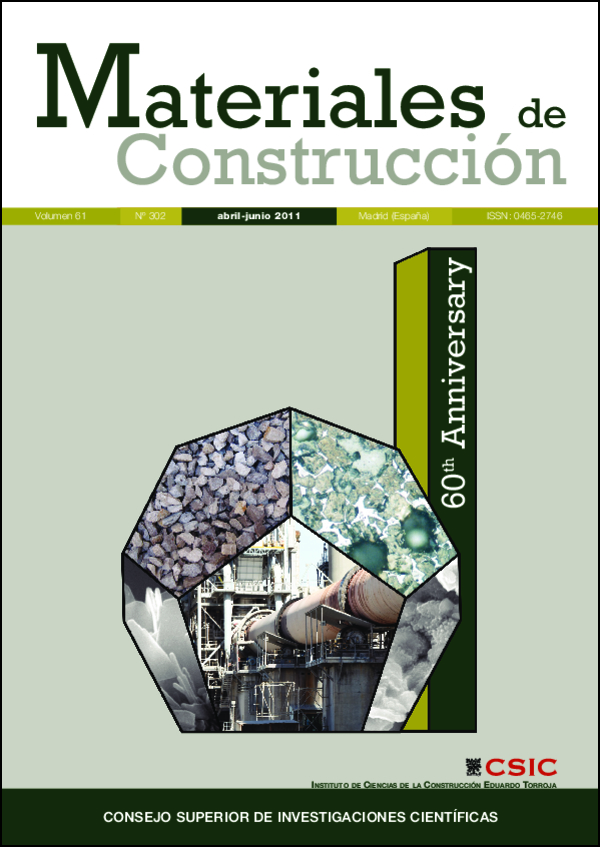Effect of the cement type on compatibility with carboxylate superplasticisers
DOI:
https://doi.org/10.3989/mc.2011.54309Keywords:
rheology, superplasticizer, Portland cement, calcium sulfoaluminate, calcium silicate hydrateAbstract
An empirical study was conducted to gain a fuller understanding of the interactions taking place in cementsuperplasticiser systems. To this end, two clinkers of known chemical and phase composition were prepared in this study to gain insight into such interactions. One contained no tricalcium aluminate (C1), while the other had a 9% C3A content (C2). These clinkers were ground to approximately 340 m2/kg and blended with gypsum only or gypsum and Klein compound (3CaO·3Al2O3·CaSO4) (1, 2). Sufficient compound was added to C1 to ensure the formation of about the same amount of ettringite after 0.5 and 1 h of hydration as found in cement C2 + gypsum. The admixture used was a carboxylate superplasticiser. Rheology measurements showed that while paste yield stress was correlated to ettringite formation, no such simple relationship was observed for plastic viscosity. Plastic viscosity depended on the total hydrates formed, i.e., not only as ettringite but also as C-S-H gel. The findings revealed that in clinkers with very low sulfate and potassium contents, the rheology of carboxylate-containing cement paste is primarily controlled by ettringite formation.
Downloads
References
(1) Erdogdu, S.: “Compatibility of superplasticizers with cements different in composition”. Cem. Conc. Res., vol. 30, nº 5 (2000), pp. 767-773.
(2) Jiang, S.; Kim, B.-G.; Aïtcin, P.-C.: “Importance of adequate soluble alkali content to ensure cement/superplasticizer compatibility”, Cem. Conc. Res., vol. 29, nº. 1 (1999), pp. 71-78.
(3) Aïtcin, P.-C.: “Domieszki: najwazniejszy skl’adnik nowoczesnego betonu”, Cement Wapno Beton, vol. 11/73, nº 5 (2006), pp. 277-284.
(4) Ramachandran, V. S.; Malhotra, V. M.; Jolicoeur, C. and Spiratos, N.: Superplasticizers, Properties and applications in Concrete, Minister of Public works and government Services, Canada, 1998.
(5) Gol’aszewski, J.: “Reologia zapraw a reologia mieszanek betonowych”, Cement Wapno Beton, vol. 11/73, nº 1 (2006), pp. 17-28.
(6) Bonen, D.; and Sarkar, S. L.: “The superplasticizer adsorption capacity of cement pastes, pore solution composition, and parameters affecting flow loss”, Cem. Conc. Res., vol. 25, nº 7 (1995), pp. 1423-1434.
(7) Nawa, T. and Eguchi, H.: “Effect of cement characteristics on the fluidity of cement paste containing an organic admixture”, 9th ICCC, vol. IV, New Delhi (1992), pp. 597-603.
(8) Prince, W.; Espagne, M.; Aïtcin, P.C.: “Ettringite formation: A crucial step in cement superplasticizer compatibility”, Cem. Conc. Res., vol. 33, nº 5, (2003), pp. 635-641.
(9) Tagnit-Hamou, A.; Baalbaki, M.; Aïtcin, P. C.: “Calcium sulphate optimization in low water/cement ratio concretes for rheological purposes”, 9th ICCC, vol. V (1992), pp. 21-25.
(10) Kim, B.G.; Jiang, S., Jolicoeur, C.; Aïtcin, P.C.: “The adsorption behavior of PNS superplasticizer and its relation to fluidity of cement paste”, Cem. Conc. Res., vol. 30, nº 6 (2000), pp. 887-893.
(11) Prince, W.; Edwards-Lajnef, M.; Aïtcin, P.C. : “Interaction between ettringite and a polynaphthalene sulfonate superplasticizer in a cementitious paste”, Cem. Conc. Res., vol. 32, nº 1 (2002), pp. 79-85.
(12) Massaza, F., and Costa, U.: “Effect of superplasticizers on the C3A hydration”, 7th ICCC, vol. IV, Paris (1980), pp. 529-534.
(13) Andersen, P. J.; Kumar, A.; Roy, D. M.; Wolfe-Confer, D.: “The effect of calcium sulphate concentration on the adsorption of a superplasticizer on a cement: Methods, zeta potential and adsorption studies”, Cem. Conc. Res., vol. 16, nº 2 (1986), pp. 255-259.
(14) Grzeszczyk, S. and Sudol’, M.: “Wpl’yw struktury superplastyfikatorów akrylowych na wl’asnos´ci reologiczne zaczynów cementowych”, Cement Wapno Beton, vol. 8/70, nº 3, (2003), pp. 156-160.
(15) Ángeles, G.; de la Torre and Aranda, M. A. G.: “Rietveld mineralogical analysis of Portland cement”, 11th ICCC, vol. 1, Durban (2003), pp. 135-145.
Downloads
Published
How to Cite
Issue
Section
License
Copyright (c) 2011 Consejo Superior de Investigaciones Científicas (CSIC)

This work is licensed under a Creative Commons Attribution 4.0 International License.
© CSIC. Manuscripts published in both the print and online versions of this journal are the property of the Consejo Superior de Investigaciones Científicas, and quoting this source is a requirement for any partial or full reproduction.
All contents of this electronic edition, except where otherwise noted, are distributed under a Creative Commons Attribution 4.0 International (CC BY 4.0) licence. You may read the basic information and the legal text of the licence. The indication of the CC BY 4.0 licence must be expressly stated in this way when necessary.
Self-archiving in repositories, personal webpages or similar, of any version other than the final version of the work produced by the publisher, is not allowed.
















